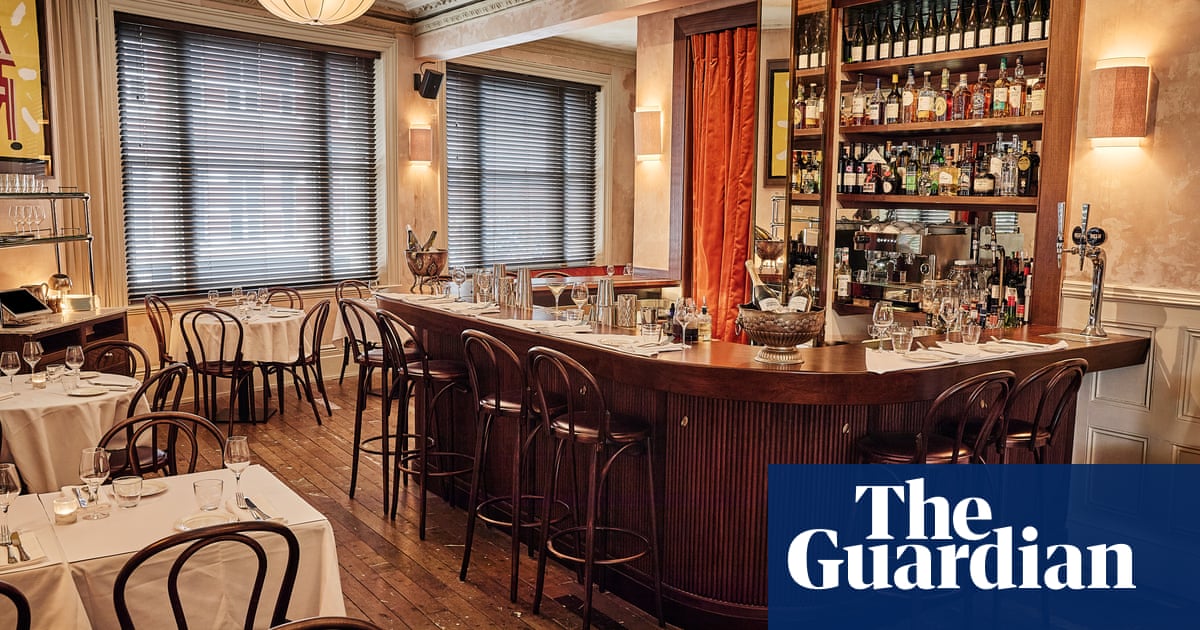As a name,One Club Rowsounds a bit like the title of a 1990s lads’ mag, but it’s actually a purposely shabby-chic room above a pub in Shoreditch that serves martinis, oysters and schnitzels in a heady, tipsy, twinkly atmosphere that itself may well remind you of the 1990s. Or at least it will if you were “on the scene” back then. These days, the 90s are synonymous with louche, raffish semi-pandemonium, mainly because today feels so saintly in comparison. No 90s restaurateur ever offered reclaimed spud peelings as a starter or a kombucha-led, alcohol-free drinks flight to spare your liver, complete with an earnest lecture on zero-waste hospitality. Puritanism was definitely out there back then, yes, though mainly only inThe Cranks Recipe Book. But mindfulness? Not so much.
What One Club Row and similar London establishments such asthe Devonshire in Piccadillyandthe Plimsoll in Finsbury Parkseem to offer, is a thrilling, retro glimpse of mindlessness. Battered stuff, things in buns, strong drinks – and the sense that, at any point, you might cop off with one ofShed SevenorWendy from Transvision Vamp.
In that same spirit, the Knave of Clubs downstairs calls itself “a proper pub” where dogs are welcome and you can “have a pint and a packet of crisps”. There are bags of Tayto’s, scotch eggs and toasties on the bar menu, and Sunday roasts. On a side street behind the pub, One Club Row has its own separate, neon-signed door, a hole in a graffitied wall, that opens to a wooden staircase – think 1990s squat party – that leads up to a long room where, by 8pm, the party will already be in full swing. Elegantly, of course – this is not a bun fight – with rather sexily dim lighting, and a long bar where you can eat a plate of pickled jalapeño gougeres while sipping one of their four house martinis (club, classic, French or olive oil).
Obviously, if, like me, you remember the 90s from their original incarnation, by 8pm you may well be thinking: “Gosh, it’s a bit late”, and “Why is the font on this menu so faint?” and “Hang on, is this actuallyLes Trois Garçons?! IthoughtI’d been here before!” If that all sounds rather expertly staged, then thank owners James Dye and Benjy Leibowitz and chefPatrick Powellfor that. It’s all very well creating a buzzy, laid-back, convivial vibe, but with Leibowitz on the floor, alongside general manager Niall Harte, things stay the right side of fancy.
Powell, meanwhile, has been one of my favourite chefs for quite some time, particularly at his former Michelin-starredAllegra in Stratford. Here, however, his menu is much more hearty than fussy or finickety. There are croquettes filled with lobster and ham, roast scallops in confit garlic butter and thick French onion soup topped with comté and gruyere.
We began with a round of those gougeres laced with cheese and sweet, spicy chilli, plus one of the chunky, crisp lobster croquettes, which dance a dainty line between anAntonin Carêmeclassic and a Findus crispy pancake. A classic steak tartare with beef-dripping bread, dressed with crisp baby gem leaves, was really very delicious, as was a remarkably pretty tuna crudo, arranged artistically with teeny slices of pickled celery and draped over a rather funky blend of smoked aubergine, creme fraiche and lemon. Zingy, smoky, delightful.
Mains are marginally even less cheffy, and major on the likes of fishcakes, pasta, moules frites, meatballs, a ribeye with chipotle mayo to share, and so on. Hell, there’s even a burger, and they won’t even resent you for ordering it. This 250g grass-fed specimen, served almost rare, may not quite be the best fancy burger in London, but it’s certainly nothing to complain about, either. The accompanying sauce au poivre, however, was a little weak and drab in comparison. The fries – just fries, mercifully, rather than truffled or faffed with in any way – come separately, with a little bowl of aïoli. A whopping pork schnitzel in a saucemoutardewith added gorgonzola was a feisty combination and, considering its size, felt a bit of a challenge.
For dessert we shared aDutch babywith chantilly, blueberries and optional smoked bacon. What is a Dutch baby, you may ask – well, it’s what those of us in this parish call a yorkshire pudding.
One Club Row isn’t fine dining by any means, and some things still need a little fine-tuning, but that isn’t really the point. They will feed you, water you, give you a good time and make you feel carefree and cosseted. And if that all sounds a bit old-fashioned, then the future suddenly feels a whole lot brighter.
One Club Row1 Club Row, London E1, oneclubrow.com (no phone). Open dinner only, Tues-Sat, 5.30-11pm. From about £50 a head for three courses, plus drinks and service
